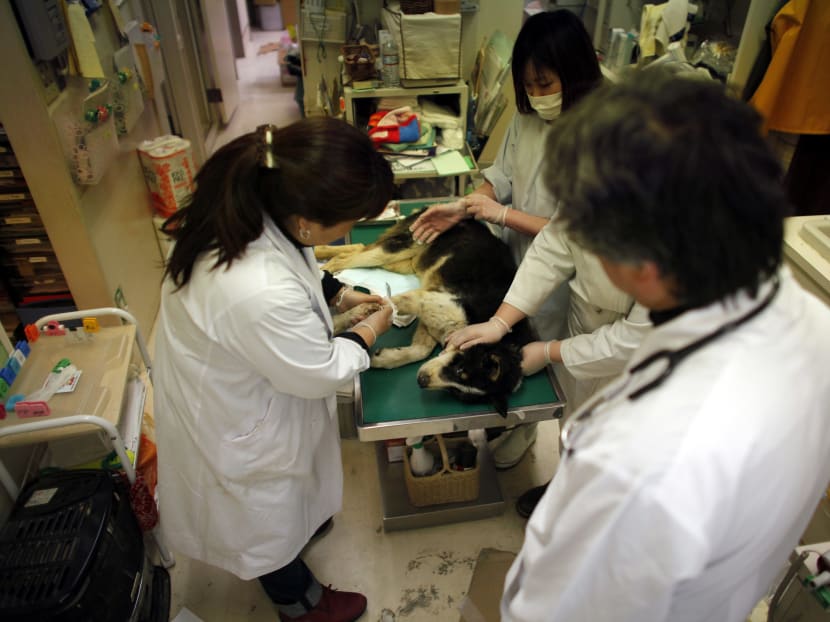Vets to beef up animal rescues during disasters in Japan
TOKYO — A campaign is under way to create emergency response teams across Japan to rescue pets and livestock during natural disasters. Formed in the wake of the Fukushima earthquake and tsunami disaster of 2011, which claimed 19,000 lives, the Veterinary Medical Assistance Team (Vmat) consists of veterinarians and animal caretakers. It was necessary to respond more effectively in times of disasters, as many people choose not to evacuate during a disaster as they do not want to leave their animals alone, said a veterinary professor.

Veterinarians examining a dog rescued from the March 11 earthquake and tsunami at the Abe Pet Clinic in Ishinomaki, Japan on April 7, 2011. Photo: Reuters
TOKYO — A campaign is under way to create emergency response teams across Japan to rescue pets and livestock during natural disasters. Formed in the wake of the Fukushima earthquake and tsunami disaster of 2011, which claimed 19,000 lives, the Veterinary Medical Assistance Team (Vmat) consists of veterinarians and animal caretakers. It was necessary to respond more effectively in times of disasters, as many people choose not to evacuate during a disaster as they do not want to leave their animals alone, said a veterinary professor.
“Usually animal welfare groups and vets do go to rescue during natural calamities ... but things got out of control during the Great East Japan Earthquake,” said Professor Shinichi Hayama of the Nippon Veterinary and Life Science University, referring to the disaster in Fukushima.
“Until then (March 2011), the trend was that people would get involved in rescue efforts on an individual basis, and do as much as they could. But (in Fukushima) tens of thousands of animals were abandoned due to the tsunami and nuclear accident,” showing a need for a system like Vmat to deal with large-scale disasters.
What hampered rescue efforts in Fukushima was the lack of a common protocol for animal rescue.
“The absence of a common language, common understanding and a common system among the rescuers, and between the rescuers and those receiving aid, made it difficult for us to deliver aid in 2011,” said Mr Masaki Okonogi, head of the Vmat in Gunma Prefecture.
So, even though Fukuoka Prefecture started the first Vmat in Japan in 2013, Prof Hayama has taken the initiative to spread the organisation.
He established a group called the Japanese Association of Disaster Veterinary Medicine in 2014. The group conducts seminars in various prefectures with the aim of establishing Vmats. Mr Okonogi also joined the group, and the Vmat in Gunma was established in 2016. Osaka followed the same year.
This year, more Vmats are expected to be formed in Nagoya and Sapporo. The Japan Veterinary Medical Association will take charge of spreading the service, with the support of Prof Hayama’s team.
The group started providing training to its members from 2014, which led to improved performance in emergency aid after a series of earthquakes hit Kumamoto Prefecture in April last year.
Prof Hayama said trained vets conduct research to find “what kind of (systematic) support is required in which area”, and that is not possible on an individual level. There are, however, many challenges ahead.
Local vets, welfare organisations and government officials need to be more aware of the Vmats’ activities.
Mr Okonogi said: “What we learnt most was the importance of consistent training for both sides – the receiving and the supporting ends – so that we can use a common language.” Further communication with animal caretakers, and more training for those receiving help is necessary to make the aid process quicker, he said.
Another issue is that vets are not recognised like doctors, architects and government officials permitted access to disaster zones, who are under the country’s Disaster Relief Act – a law designed to protect victims of disasters and maintain social order. The latter groups are all provided an allowance and compensation in cases of accidents or death, but vets are not guaranteed the same treatment.
Even if they are allowed access to designated areas, they play a limited role as “volunteers”, which is a hindrance in attracting help, said Prof Hayama.
Another issue is that animals may need to be in a shelter for longer periods – up to a month or more – as they develop stress and related conditions, requiring a large number of people who can work on them in rotating shifts.
To deal with this, Tokyo and Gunma prefectures have signed a pact with their municipalities to provide volunteers with allowances and compensation.
Prof Hayama believes in the importance of spreading Vmats throughout the nation to handle such crises.
“Hundreds of thousands of animals are expected to be affected if an inland earthquake hits Tokyo or the Nankai Trough off central and western Japan, and they cannot be aided just with the help of volunteers,” said Prof Hayama. He stressed the need for early preparation and training. “You cannot expect the Vmat of the region that has been affected by a (disaster) to respond, and therefore support is required from areas not affected by it. You never know when a calamity will hit, so it is important to have Vmats everywhere.”
The need to change the Disaster Relief Act to give vets more recognition aside, the public needs to be more aware of the vets’ work, such as their rescue efforts during the Kumamoto disaster on Kyushu Island, he added.
The Kumamoto earthquakes of April last year caused dozens of human deaths and livestock damage. Disaster relief efforts were stretched due to multiple aftershocks over days. Rescued residents were photographed sleeping with their pet dogs. Some 600 beef cows, 550 pigs, and 540,000 birds died or had to be culled after the earthquakes. KYODO NEWS






